Medical expert of the article
New publications
Preparations
Breast cancer pills
Last reviewed: 04.07.2025

All iLive content is medically reviewed or fact checked to ensure as much factual accuracy as possible.
We have strict sourcing guidelines and only link to reputable media sites, academic research institutions and, whenever possible, medically peer reviewed studies. Note that the numbers in parentheses ([1], [2], etc.) are clickable links to these studies.
If you feel that any of our content is inaccurate, out-of-date, or otherwise questionable, please select it and press Ctrl + Enter.
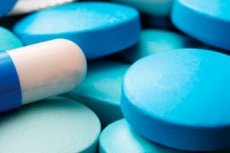
A breast tumor with signs of malignancy indicates cancer. This problem is relevant for women of all ages, since about 20% of cancerous tumors occur in the mammary glands. Every year this pathology gets younger and spreads. Previously, the disease was detected in women over 40 years old, now there are cases of patients under 30 years old. Based on this, the demand for breast cancer pills is growing.
Treatment tactics and choice of drugs depend on the stage of the disease and the general health of the patient. Oncologists distinguish the following types of tumors:
- ERC-positive, that is, the tumor contains estrogen receptors. The tumor grows rapidly, as it receives regular nourishment from the hormone. Estrogen promotes rapid growth and proliferation of cancer cells.
- ERc-negative. In the second type of cancer, anti-estrogen drugs are used that block tumor receptors. Thanks to this, the cancer slows down its growth. In pharmacology, such drugs are called selective estrogen receptor modulators.
Today, there are several methods of treating breast cancer: radiation therapy, surgery, hormone therapy, chemotherapy, and drug therapy. In most cases, these methods are combined with each other to achieve the best result.
Let's look at two treatment methods that involve the use of cancer pills:
- Chemotherapy
The drugs in this group damage malignant cells by disrupting their DNA. Due to this, the cells do not divide and die. This method has two types:
- Adjuvant chemotherapy is used in the absence of a pronounced cancer process, that is, to destroy metastases.
- Neoadjuvant chemotherapy – used before the main therapy, for example, before surgery. It is aimed at reducing the size of the tumor. The action of the drugs makes it possible to perform organ-preserving surgery and determine the level of sensitivity of cancer cells to chemotherapy.
The method is carried out cyclically, prescribing tablets and injections to patients. The main disadvantage of such treatment is a number of side effects: nausea, vomiting, diarrhea, pathological effects on the central nervous system.
- Hormone therapy
It is used for hormone-dependent tumors, to eliminate metastases and prevent secondary oncological disease after therapy. Most often, patients are prescribed the following drugs: blockers of hormonal receptors of malignant cells (Toremifene, Tamoxifen) and blockers of estrogen synthesis (Femara, Arimidex, Letrozole). Hormonal therapy can cause complications, for example, the drug Tamoxifen provokes endometrial hyperplasia, exacerbation of varicose veins and other side effects.
Chemotherapy and hormone therapy are two methods that differ in their effectiveness. The doctor chooses the one that is most effective for the current stage of cancer, the prevalence of metastases, and other features of the female body. Thus, hormone therapy is effective for metastases in soft tissues and bones, and chemotherapy for metastases in the liver, lungs, and the aggressiveness of the pathological process.
It is simply impossible to choose pills for breast cancer on your own. Only after a comprehensive diagnosis, determining the stage of the disease, the location of the tumor and its size, can drugs be prescribed. In this case, pills will not be the only method of treatment, rather they will act as an additional therapy.
Tamoxifen
Antiestrogenic drug with antitumor properties. Tamoxifen is available in tablet form with the active ingredient - tamoxifen citrate. The auxiliary components are: calcium dihydrogen phosphate, lactose, colloidal silicon dioxide, magnesium stearate, povidone and others.
The drug has estrogenic properties. Its effectiveness is based on blocking estrogens, and metabolites bind to cytoplasmic hormone receptors in the tissues of the mammary glands, vagina, uterus, tumors with increased estrogen content and the anterior pituitary gland. The tablets do not stimulate DNA synthesis in the nucleus of malignant cells, but inhibit their division, causing regression and death.
After oral administration, it is rapidly absorbed, the maximum concentration in the blood plasma is observed within 4-7 hours (with a single dose). The level of binding to plasma proteins is 99%. It is metabolized in the liver, excreted in feces and urine.
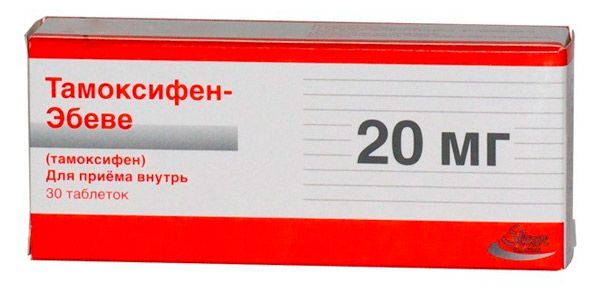
- Indications for use: breast cancer in women (estrogen-dependent, especially during menopause) and mammary glands in men. Suitable for the treatment of cancerous lesions of the ovaries, endometrium, prostate gland, kidneys, as well as melanoma, soft tissue sarcoma, in the presence of estrogen in neoplasms. Prescribed for resistance to other medications.
- The method of administration and dosage are individual for each patient and depend on medical indications. The daily dose is 20-40 mg, the standard treatment regimen involves the use of 20 mg daily, for a long time. If signs of disease progression appear during therapy, the drug is discontinued.
- Contraindications: individual intolerance to the components, pregnancy and breastfeeding. With special caution it is prescribed for patients with diabetes mellitus, ophthalmological diseases, renal failure, thrombosis. And also with leukopenia and the use of indirect anticoagulants.
- Side effects are related to the antiestrogenic effect and manifest as paroxysmal sensations of drowsiness, itching in the genital area, weight gain and vaginal bleeding. In rare cases, swelling, nausea, vomiting, increased fatigue and depression, headaches and confusion, skin allergic reactions occur. Overdose has similar symptoms.
When using the drug, it is necessary to take into account the fact that the tablets increase the risk of pregnancy, which is contraindicated during treatment. Therefore, during therapy, it is very important to use non-hormonal or mechanical contraceptives. During cancer treatment, women should undergo regular gynecological examinations. If bloody discharge from the vagina or bleeding occurs, then the tablets are stopped.
Letromara
Nonsteroidal aromatase inhibitor (an enzyme that synthesizes estrogens in the postmenopausal period). Letromara converts androgens synthesized by the adrenal glands into estradiol and estrone. The drug reduces the concentration of estrogens by 75-95%. After administration, the tablets are quickly and completely absorbed from the digestive tract. Food intake slows down the rate of absorption, but does not change the degree of absorption. Bioavailability is 99%, with 60% of the drug bound to plasma proteins. Long-term treatment does not cause cumulation. Metabolism occurs with cytochrome P450 isoenzymes - CYP 3A4. It is excreted as metabolites in the urine and feces.

- Indications for use: breast cancer (widespread) in postmenopause or after long-term use of antiestrogens. Prescribed for localized hormone-dependent cancer after surgical treatment and for prophylactic purposes.
- Method of administration and dosage: 2.5 mg per day daily. Therapy is long-term, until the disease relapses. The drug does not require dosage adjustment for elderly patients or patients with impaired renal and hepatic function.
- Side effects: dizziness and headaches, muscle weakness, nausea and vomiting, diarrhea, swelling, vaginal bloody discharge and bleeding. Dermatological reactions are also possible - itching, rash, alopecia and endocrine system disorders - increased sweating, weight loss or gain.
- Contraindications: intolerance to the components of the product, premenopausal period, kidney and liver diseases, pregnancy and lactation, age of patients under 18 years. During treatment, it is necessary to be careful when driving machinery and vehicles, as there may be attacks of dizziness and headaches.
Anastrozole
An antitumor agent that inhibits estrogen synthesis. Anastrozole suppresses aromatase and prevents the transformation of androstenedione into estradiol. Therapeutic doses reduce estradiol by 80%, which is effective in estrogen-dependent tumors during postmenopause. Does not have estrogenic, progestogenic or androgenic properties. It is available in tablet form. The active ingredient is anastrozole, the auxiliary components are: hypromellose, magnesium stearate, titanium dioxide, povidone-K30 and others.
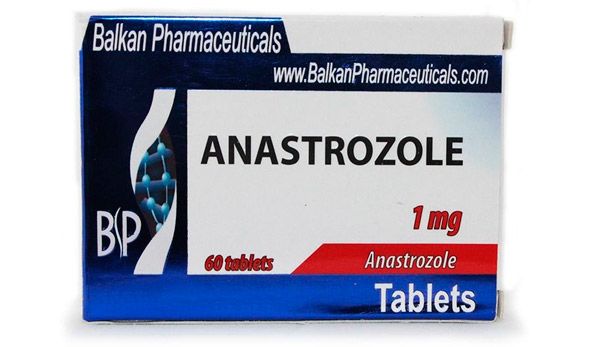
- Indications for use: hormone-dependent breast cancer in the early stages and in the postmenopausal period, widespread cancer, tumors resistant to tamoxifen. The dosage is calculated for each patient individually. The standard regimen is 1 mg per day, the course of treatment is long.
- Side effects: asthenic syndrome, drowsiness, increased fatigue and anxiety, insomnia, dry mouth, abdominal pain, nausea and vomiting, dizziness and headaches, paresthesia, rhinitis, myalgia, alopecia, back pain and other negative reactions. Overdose is accompanied by similar symptoms. Symptomatic therapy, intake of absorbents and gastric lavage are indicated to eliminate these reactions.
- Contraindications: intolerance to anastrozole and other components of the drug, use of tamoxifen, pregnancy and lactation, liver and kidney failure, treatment with estrogen-containing medications, indications during premenopause. When interacting with other drugs, it is necessary to pay attention to the fact that estrogens and Tamoxifen reduce the effectiveness of Anastrozole.
Zoladex
A pharmacological agent from the group of hormone synthesis inhibitors that affect the synthesis of gonadotropins. Zoladex is a synthetically synthesized hormonal drug. Its active ingredient is goserelin. The drug inhibits the pituitary synthesis of luteinizing and follicle-stimulating hormones. This causes a decrease in the level of testosterone and estradiol in the blood. It is available in capsules of 3.6 and 10.8 mg, each capsule is in a syringe applicator with an aluminum envelope.
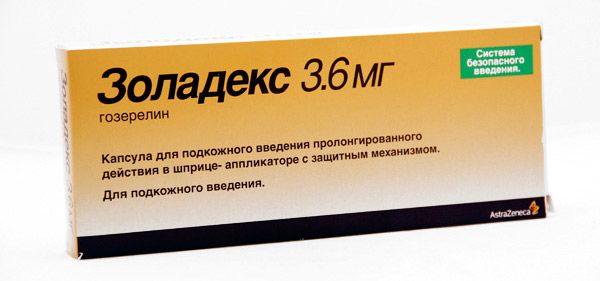
- Indications for use: hormone-dependent breast cancer in women of reproductive age and premenopause. Prescribed for thinning of the endometrium before surgery, endometriosis, malignant lesions of the prostate gland, uterine fibroids. The capsules are intended for subcutaneous administration into the anterior abdominal wall. The injection is done every 28 days, the standard course of therapy is 6 capsules.
- Side effects: vaginal bleeding, skin allergic reactions, amenorrhea, decreased libido, dizziness and headaches, decreased mood, mental disorders, paresthesia, hot flashes, heart failure, blood pressure surges and much more. Signs of overdose have similar symptoms. Symptomatic therapy is indicated to eliminate them.
- Contraindications: hypersensitivity to the components of the drug, goserelin and its structural analogues. Not used during pregnancy and lactation, for the treatment of pediatric patients. With special caution, it is prescribed in case of a tendency to ureteral obstruction, IVF against the background of polycystic ovary disease and compression lesions of the spine.
Melphalan
An anticancer drug whose action is based on damaging the DNA molecule of a cancer cell and forming defective forms of RNA and DNA that stop protein synthesis. Melphalan is active against passive tumor cells. Stimulates proliferative processes in tissues surrounding neoplasms. Available in two forms: tablets for oral administration and injections.
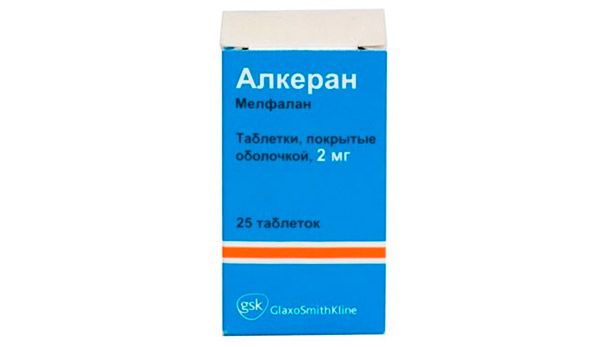
- Indications for use: breast cancer, multiple myeloma, polycythemia, progressive neuroblastoma, soft tissue sarcoma of the extremities, rectal and colon cancer, malignant blood lesions.
- The drug is taken orally, intraperitoneally, using hyperthermic regional perfusion and intrapleurally. The dosage is individual for each patient and depends on the general indications. The average duration of treatment is from 1 year.
- Side effects: gastrointestinal bleeding, stomatitis, nausea and vomiting, diarrhea, cough and bronchospasm, vaginal bleeding, painful urination, swelling, skin allergic reactions, development of infections, increased body temperature.
- Contraindications: hypersensitivity to components, suppression of bone marrow function. Use with special caution in arthritis, chickenpox, urolithiasis. As well as in radiation or cytotoxic therapy.
- Overdose: attacks of nausea and vomiting, impaired consciousness, muscle paralysis and convulsions, stomatitis, diarrhea. Symptomatic therapy is indicated to eliminate these reactions. If the overdose is severe, hospitalization and monitoring of vital functions are required. Hemodialysis is ineffective.
Streptozocin
An antitumor drug with alkylating properties from the group of nitrosourea derivatives. Streptozocin has a destructive effect on cancer cells, prevents their division and causes death.
- Indications for use: carcinoid tumors, malignant lesions of the pancreas (progressive metastatic or clinically expressed cancer). The dosage is individual for each patient and depends on the indications, the treatment regimen used and the severity of side effects.
- Contraindications: chickenpox, herpes zoster, hypersensitivity to streptozocin, pregnancy and lactation, impaired renal and hepatic function. With special caution, prescribe to patients with diabetes mellitus, acute infectious diseases and with previous treatment with cytotoxic agents or radiation therapy.
- Side effects: nausea, vomiting and diarrhea, glycosuria, renal acidosis, in rare cases leukopenia and thrombocytopenia, diabetogenic reactions, infections. Symptomatic therapy and drug withdrawal are indicated to eliminate them.
Thiotepa
Immunosuppressant, antitumor agent from the pharmacological group of cytostatics. Thiotepa is a trifunctional alkylating compound from the nitrogen mustard group. Its activity is associated with changes in DNA functions and effects on RNA. This leads to disruption of nucleic acid metabolism, blocks protein biosynthesis and cancer cell division processes.
It has a carcinogenic and mutagenic effect. Long-term use of the drug may cause the development of secondary malignant tumors and degenerative changes in the sex glands. This entails amenorrhea or azoospermia and other pathologies. The tablets are absorbed systemically, the level of absorption depends on the dosage. Metabolizes in the liver, forming metabolites. Excreted by the kidneys with urine.
- Indications for use: breast cancer, lung cancer, bladder cancer. Effective in the treatment of pleural mesothelioma, exudative pericarditis, peritonitis, malignant lesions of the meninges, lymphogranulomatosis, lymphosarcoma, reticulosarcoma.
- The method of administration and dosage are individual for each patient. For breast cancer, take 15-30 mg 3 times a week, the treatment is 14 days. There should be a break of 6-8 weeks between each course.
- Contraindications: hypersensitivity to components, leukopenia, thrombocytopenia, cachexia and severe anemia, pregnancy and lactation. It is used with special caution in chickenpox, systemic infections, gout, urolithiasis, for the treatment of pediatric and elderly patients.
- Side effects of the substance: gastrointestinal bleeding, nausea and vomiting, stomatitis, headaches and dizziness, swelling of the lower extremities, cough and swelling of the larynx, cystitis, back and joint pain, skin and local allergic reactions.
- Overdose: nausea, vomiting, bleeding, fever. Symptomatic therapy is indicated to eliminate these reactions, in particularly severe cases – hospitalization and transfusion of blood components.
Chlorambucil
An effective drug prescribed for the treatment of breast cancer. Chlorambucil has antitumor and immunosuppressive properties. After entering the body, it binds to the nucleoproteins of cell nuclei, affecting the DNA chains of tumor cells. It has a toxic effect on dividing and non-dividing cells, inhibits tumor and hematopoietic tissue. When administered orally, it is quickly and completely absorbed from the gastrointestinal tract, binding to plasma proteins is 99%. It breaks down into metabolites and is excreted by the kidneys in the urine.
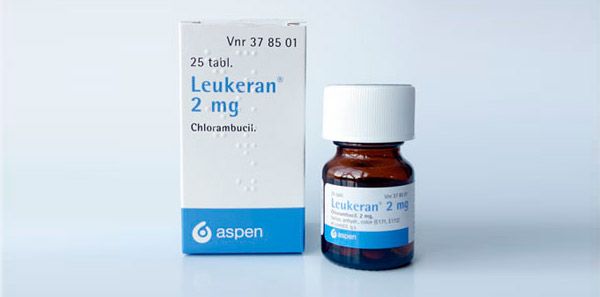
- Indications for use: malignant tumors of the mammary glands, ovaries, chorioepithelioma of the uterus, myeloma, nephrotic syndrome, lymphogranulomatosis, chronic lymphocytic leukemia. The dosage is selected individually for each patient and adjusted during therapy based on the clinical effect.
- Side effects: gastrointestinal bleeding, nausea and vomiting, liver dysfunction, stomatitis, leukopenia, anemia, acute leukemia, hemorrhage, cough and shortness of breath, difficulty urinating, tremors of the limbs and muscle pain, allergic skin reactions, development of infections and increased body temperature.
- Contraindications: intolerance to the components of the drug and other alkylating drugs, epilepsy, severe liver dysfunction, leukopenia. With special caution it is prescribed for cancer patients with chickenpox, shingles, with suppression of bone marrow function, with gout, urolithiasis and head injuries and convulsive disorders.
- Overdose: CNS dysfunction, epileptic seizures, increased side effects. Symptomatic therapy and broad-spectrum antibiotics are used for treatment. Hemodialysis is ineffective.
Cyclophosphamide
A cytostatic agent that is aimed at destroying cancer cells. Cyclophosphamide is biotransformed in the liver, forming active metabolites with alkylating properties. These substances attack the nucleophilic centers of protein molecules of pathological cells, forming cross-links between DNA alleles and blocking the growth and reproduction of cancer cells. The drug has a broad spectrum of antitumor activity. Its long-term use can cause the development of secondary malignant tumors.
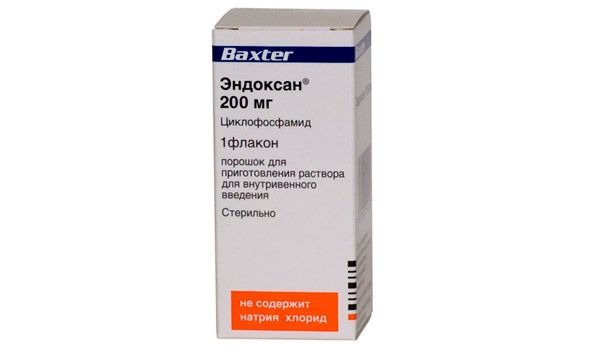
After oral administration, it is rapidly absorbed, bioavailability is 75%. Plasma protein binding is low, 12-14%. Biotransformed in the liver, forming active metabolites. Passes through the placental barrier and enters breast milk. Excreted in the urine as metabolites and 10-25% unchanged.
- Indications for use: breast cancer, lung cancer, ovarian cancer, cervix and uterine body cancer, bladder cancer, testicle cancer, prostate cancer. Prescribed for neuroblastoma, angiosarcoma, lymphosarcoma, leukemia and lymphogranulomatosis, osteogenic sarcoma, Ewing's sarcoma, as well as autoimmune diseases (systemic connective tissue lesions, nephrotic syndrome).
- The drug is administered intraperitoneally and intrapleurally. The choice of administration method and dosage depends on the chemotherapy regimen and general indications. The dosage is selected for each patient individually. The course dose is 80-140 mg, followed by a transition to a maintenance dose of 10-20 mg twice a week.
- Contraindications: intolerance to the components of the drug, severe renal dysfunction, leukopenia, thrombocytopenia, severe anemia, bone marrow hypoplasia, pregnancy and breastfeeding, thermal stages of cancer. It is used with special caution to treat patients under 18 years of age and the elderly.
- Side effects: stomatitis, nausea and vomiting, gastrointestinal pain and bleeding, jaundice, dry mouth. But most often, patients complain of dizziness and headaches, bleeding and hemorrhage, shortness of breath, various disorders of the cardiovascular system, skin allergic reactions.
- Overdose: nausea and vomiting, fever, hemorrhagic cystitis, dilated cardiomyopathy syndrome. Symptomatic therapy is used for treatment. In severe cases, hospitalization and monitoring of vital functions are indicated. If necessary, transfusion of blood components, administration of hematopoiesis stimulants and antibiotics are performed.
Gemcitabine
A drug used for malignant lesions of the mammary gland and other organs. Gemcitabine contains the active substance gemcitabine hydrochloride. It has a pronounced cytotoxic effect, killing cancer cells at the stage of DNA synthesis.
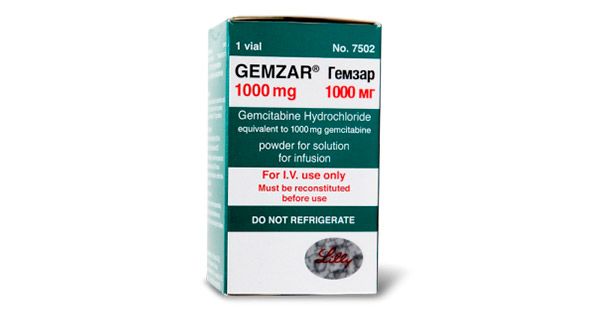
When administered by injection, it spreads rapidly throughout the body. The maximum plasma concentration is reached within 5 minutes after infusion. The half-life depends on the patient's age and gender, as well as the dosage used. As a rule, it takes from 40-90 minutes to 5-11 hours from the moment of administration. Metabolizes in the liver, kidneys, other organs and tissues, forming metabolic compounds. Excreted in the urine.
- Indications for use: complex treatment of metastatic or locally advanced breast cancer (may be prescribed in combination with Paclitaxel and Anthracycline). Tumor lesions of the bladder, metastatic adenocarcinoma of the pancreas, metastatic non-small cell lung cancer, epithelial ovarian cancer.
- Gemcitabine is used only by prescription. In breast cancer, combination therapy is used. The recommended dosage is 1250 mg per m2 of the patient's body on days 1 and 8 of treatment in a 21-day cycle. The drug is combined with Paclitaxel 175 mg per m2 on the first day of the 21st cycle. The drug is administered intravenously by drops over 180 minutes. The dosage is reduced with each subsequent cycle.
- Side effects: nausea and vomiting, increased liver transaminases and alkaline phosphatase, shortness of breath, allergic skin rashes, itching, hematuria. Neutropenia and anemia are possible with combination therapy. Similar symptoms appear with overdose. There is no antidote; blood transfusion and other symptomatic therapy methods are used for treatment.
- Contraindications: hypersensitivity to the components of the drug, pregnancy and breastfeeding.
Tegafur
Cytostatic agent, blocks DNA synthesis and thymidylate synthetase, makes cancer cells defective, destroying them. Tegafur has antitumor, analgesic and anti-inflammatory effects. Large doses of the drug inhibit hematopoiesis. When taken orally, it is quickly absorbed from the gastrointestinal tract, absorption is incomplete due to the first pass through the liver. It is excreted in urine and feces.
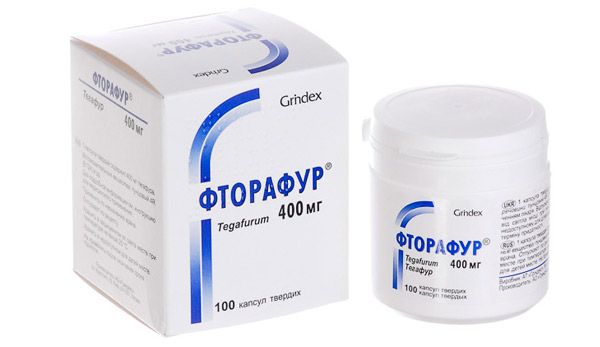
- Indications for use: malignant tumors of the mammary gland, liver, stomach, bladder, prostate, head and skin, uterus, ovaries. Effective in skin lymphoma, phonophoresis and diffuse neurodermatitis.
- Dosage and method of administration: orally 20-30 mg/kg 2 times a day with an interval of 12 hours. The course of therapy lasts 14 days, repeated after 1.5-2 months. During treatment, careful oral care and vitamin therapy are required.
- Contraindications: individual intolerance to the components of the product, terminal stages of cancer, pronounced changes in blood composition, anemia, suppression of bone marrow hematopoiesis, ulcerative diseases of the stomach and duodenum. Not used during pregnancy and lactation.
- Side effects: confusion, increased lacrimation, thrombocytopenia and leukopenia, myocardial infarction, sore throat, dry, itchy and flaky skin, gastrointestinal bleeding. Symptomatic therapy or drug discontinuation are indicated to eliminate them.
Vinblastine
Chemotherapeutic antitumor drug. Vinblastine contains alkaloids of plant origin. Blocks metaphases of cellular mitosis by binding to microtubules. The active components of the drug selectively inhibit DNA and RNA synthesis by inhibiting the enzyme RNA polymerase.
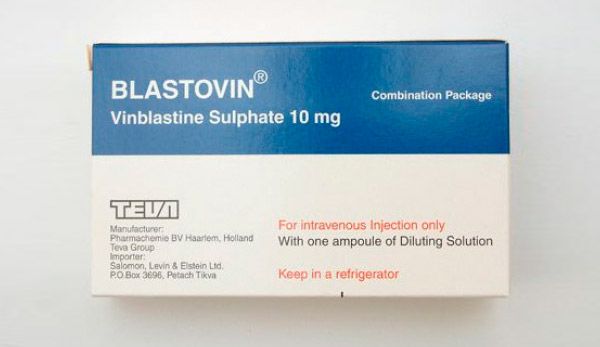
It is produced in the form of lyophilized powder for the preparation of injection solution of 5 and 10 g. The drug comes with ampoules of solvent of 5 and 10 ml, respectively. After intravenous administration, it quickly spreads throughout the body, does not penetrate the blood-brain barrier. It is biotransformed in the liver, forming active metabolites, and is excreted by the intestines. The half-life is 25 hours.
- Indications for use: malignant neoplasms of various etiologies and localizations, including non-Hodgkin's lymphomas, testicular cancer, chronic leukemia and Hodgkin's disease. The standard dose of the drug is 0.1 mg/kg, injections are administered once a week. If necessary, the dosage can be increased to 0.5 mg/kg. During the treatment period, it is necessary to monitor the level of leukocytes in the blood and the level of uric acid.
- Contraindications: intolerance to the components of the drug, viral and bacterial infections. With special caution, it is prescribed to patients with recent radiation or chemotherapy, as well as with leukopenia, severe liver damage and thrombocytopenia. The use of Vinblastine for pregnant women is possible in the case when the potential benefit to the mother is higher than the risks to the fetus.
- Side effects: alopecia, leukopenia, muscle weakness and pain, nausea and vomiting, stomatitis, thrombocytopenia. Gastric bleeding and hemorrhagic colitis may also develop. The drug may have a neurotoxic effect, causing double vision, depressive disorders, headaches.
- Signs of overdose are similar to side effects. Their severity and intensity depend on the dose taken. There is no specific antidote, so symptomatic therapy is carried out. In this case, it is necessary to monitor the blood condition and, in severe cases, perform a blood transfusion.
Vincristine
A pharmacological agent used to treat malignant neoplasms. Vincristine is available in 0.5 mg ampoules with a solvent. It is used in the complex therapy of acute leukemia, lymphosarcoma, Ewing's sarcoma and other malignant pathologies. The drug is administered intravenously at intervals of 7 days. The dosage is individual for each patient. The standard dose is 0.4-1.4 mg/m2 of the patient's body surface. During the procedure, it is necessary to avoid getting the drug in the eyes and on surrounding tissues, as this can provoke a strong irritant effect and tissue necrosis.
Contraindicated to dissolve in the same volume with Furosemide solution, as a precipitate is formed. Increased doses can provoke the following side effects: numbness of the limbs and muscle pain, hair loss, dizziness, weight loss, increased body temperature, leukopenia, nausea and vomiting. The frequency of side effects depends on the total dose and duration of treatment.
Vinorelbine
An antitumor injection drug available in 1 and 5 ml vials. Vinorelbine contains the active substance vinorelbine ditartrate. After administration, it suppresses the division of cancer cells, blocks their further proliferation, causing death. It is used for various malignant diseases, including lung cancer. The drug is administered intravenously only. If the substance gets into the surrounding tissues during the procedure, it causes their necrosis. The dosage is individual for each patient.
Contraindicated for use in cases of severe liver dysfunction, for pregnant women and during lactation. Not used simultaneously with X-ray therapy involving the shoulder area. Main side effects: anemia, muscle spasms, paresthesia, intestinal obstruction, nausea and vomiting, difficulty breathing, bronchospasms.
Carubicin
An antitumor drug from the pharmacological group of anthracycline antibiotics. Carubicin has a mechanism of action associated with DNA damage in the S-phase of mitosis. It is used for soft tissue sarcoma, neuroblastoma, Ewing's sarcoma, chorionepithelioma. The dosage depends on the stage of the disease, the state of the patient's hematopoietic system and the treatment regimen.
Contraindicated for use in severe cardiovascular diseases, liver and kidney dysfunction, during pregnancy and lactation, hypersensitivity to the components of the drug and with a leukocyte count below 4000/mcl and platelets below 100,000/mcl. Common side effects: leukopenia, heart pain, heart failure, nausea and vomiting, nephropathy, decreased blood pressure, alopecia, gouty arthritis.
Fotretamine
An alkaloid, an ethyleneimine derivative. Fotretamine inhibits granulocytopoiesis, thrombocytopoiesis and erythropoiesis. Reduces the size of the lymphatic and peripheral nodes of the liver and spleen. Does not have an antitumor effect on the intrathoracic lymph nodes. Restores normal levels of leukocytes in the peripheral blood within a month.
- Indications for use: erythremia, lymphocytic leukemia, ovarian cancer, reticulosarcoma, fungal mycosis, Kaposi's angioreticulosis. The drug is administered intravenously, intraperitoneally and intramuscularly, dissolving 10 ml in an isotonic sodium chloride solution. The dosage and duration of treatment are determined by the doctor.
- Contraindications: hypersensitivity to the components of the drug, leukopenia, terminal stage cancer, kidney and liver disease.
- Side effects: anemia, loss of appetite, headaches, nausea, leukopenia, thrombocytopenia. If these reactions develop, blood transfusions are performed, B vitamins and leukopoiesis stimulants are prescribed.
Pertuzumab
An effective drug used for cancer lesions of the body. Pertuzumab is produced using recombinant DNA technology. It interacts with the extracellular subdomain, blocking growth factor receptors and ligand-dependent heterodimerization of HER2 with other proteins of the HER family. The monoagent inhibits the proliferation of cancer cells.
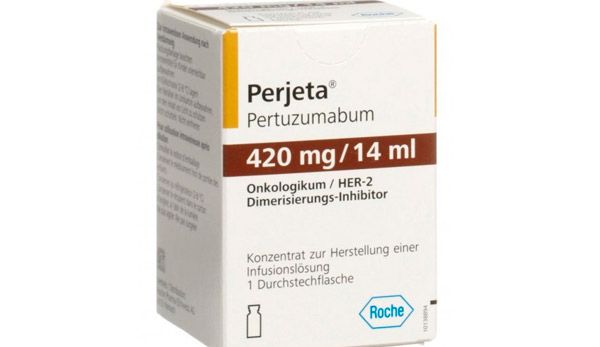
- Indications for use: breast cancer (metastatic, locally recurrent) with tumor overexpression of HER2. In most cases, it is used in combination with Docetaxel and Trastuzumab, provided that such therapy has not been previously administered and there is no progression of the disease after adjuvant treatment.
- Pertuzumab is administered intravenously by drip or jet. Before treatment, testing for tumor expression of HER2 is performed. The standard dose is 840 mg as an hourly drip infusion. The procedure is performed every three weeks.
- Contraindications: pregnancy and lactation, patients under 18 years of age, cardiovascular disorders, liver dysfunction. It is used with particular caution in case of previous therapy with Trastuzumab, Anthracyclines or radiation therapy.
- Side effects: hypersensitivity reactions, neutropenia, leukopenia, decreased appetite, insomnia, increased lacrimation, congestive heart failure, shortness of breath, nausea, vomiting and constipation, stomatitis, muscle pain, myalgia, increased fatigue, swelling, secondary infections.
- Overdose is similar in its symptoms to side effects. Symptomatic therapy is indicated to eliminate it. In particularly severe cases, hospitalization and blood transfusion are required.
Herceptin
A medicinal product of humanized recombinant DNA (derivatives of monoclonal bodies). Herceptin contains an active substance that inhibits the proliferation of tumor cells with HER2 hyperexpression. HER2 hyperexpression is associated with a high percentage of primary breast cancer and common gastric tumors. It is available as a lyophilisate of 150 and 440 mg, with each vial containing 20 ml of solvent.
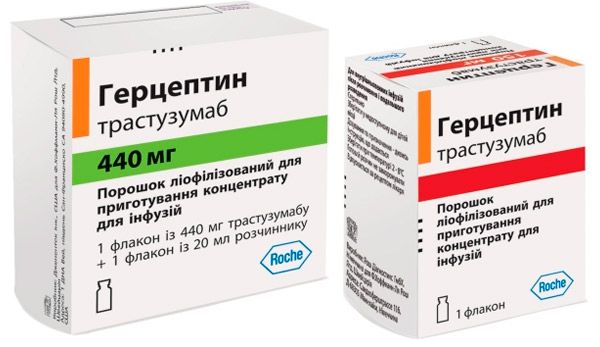
- Indications for use: metastatic breast cancer with HER2 hyperexpression by tumor cells and its early stages, widespread adenocarcinoma of the stomach and esophagogastric junction. The drug can be used as monotherapy or in combination with Paclitaxel, Docetaxel and other antitumor agents.
- Before starting treatment, it is necessary to check for HER2 expression by the tumor. The drug is administered intravenously by drip. In breast oncology, 4 mg/kg is used as a loading dose and 2 mg/kg as a maintenance dose. Infusions are performed once a week. In combination therapy, the procedure is performed once every 21 days. The number of cycles and duration of treatment are determined by the attending physician, individually for each patient.
- Contraindications: pregnancy and breastfeeding, pediatric patients, hypersensitivity to trastuzumab and other ingredients of the drug, severe shortness of breath (caused by metastases in the lungs or requiring oxygen therapy). The drug is prescribed with caution for angina pectoris, arterial hypertension, myocardial insufficiency.
- Side effects: pneumonia, cystitis, sinusitis, thrombocytopenia, neutropenic sepsis, dry mouth, nausea, vomiting and constipation, angioedema, urinary tract infections, sudden weight loss, tremors of the extremities, muscle pain, skin hypersensitivity reactions, dizziness and headaches, insomnia, loss of sensation.
- The drug does not cause overdose symptoms. It is contraindicated to mix Herceptin with other drugs. It has chemical incompatibility with dextrose solution, and when used with anthracyclines increases the risk of cardiotoxicity.
Attention!
To simplify the perception of information, this instruction for use of the drug "Breast cancer pills" translated and presented in a special form on the basis of the official instructions for medical use of the drug. Before use read the annotation that came directly to medicines.
Description provided for informational purposes and is not a guide to self-healing. The need for this drug, the purpose of the treatment regimen, methods and dose of the drug is determined solely by the attending physician. Self-medication is dangerous for your health.


 [
[